Researching Game — Where Have All the Geography Majors Gone?
In this blog post, I want to report my researching on Geography games in the past week. Initially, I thought it would be very easy for me to find a couple of high-quality serious games or simulations for introduction to Geography major. Since I used quite frequently a lot of applications based on Geography – google map, Uber, Zillow (recently, I have been searching for new apartment rentals for next school year)… However, when I formally started to do the search, the difficulty was beyond my imagination. Finally, I only got a few directly related games about Geography major introduction.
Before searching, I tended to clarify the definition of Geography. With better understanding about the definition of Geography, I could trace the targeted games more accurately. I preferred the definition of Geography from the National Geography website after I compared different descriptions of “What is Geography” from different references, “Geography is the study of places and the relationships between people and their environments. Geographers explore both the physical properties of Earth’s surface and the human societies spread across it. They also examine how human culture interacts with the natural environment, and the way that locations and places can have an impact on people. Geography seeks to understand where things are found, why they are there, and how they develop and change over time(Geography, n.d.).”
Beyond the definition, I knew that as an expansive discipline, geography covers a lot of study which can always be confused with other disciplines in Environment Sciences and GeoScience. About three-quarters of graduates from the doctoral program become college professors or join college faculties(Beck, 2019). Then, based on the better understanding about what Geography as a major focuses on, I used the following platforms and methods to do the searching.
What did I find?
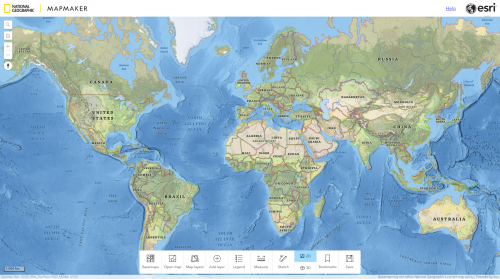
- I found this game on the website of National Geographic. I used “game” as a keyword and spotlighted the game from the search results.
- The core dynamic of this simulation is exploration. The purpose of this simulation is to invite learners to explore anywhere on the planet earth they interested in, and design a map with different layers which they want to have on the map. The different layers include many categories which can meet the designers’ personal preferences and help them understand the meaning of maps, as well as the work details of geographers.
- All ages will be welcome to use. The higer standard functions will be more suitable for high-school students and college students who are going to prefer geography as their majors.
- Geographical Adventures (Under Construction)
- https://sebastian.itch.io/geographical-adventures
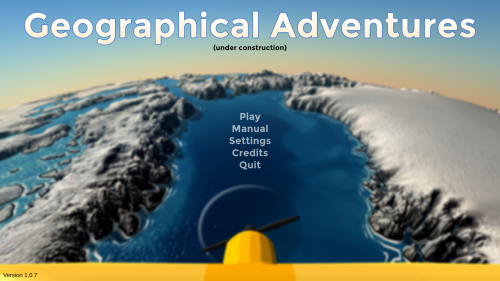
- Firstly, I found an introduction video of the game from youtube, then I trace the game on itchi.io and github.
- It is a little game under development. The Core dynamics of the game are exploration and collecting. The game rules are simple: fly around the world, picking up packages and delivering them to various cities as players go. There are three locations marked at the top of the screen. At each location, players will find a hot air balloon waiting with a package for the players to collect. Fly the plane through the balloons to collect the packages. Once the package has been picked up, its location at the top of the screen will change to a delivery address. Fly over to that city based on geography knowledge and drop the package off there.
- All ages, especially designed for the players who want to change their understanding about world map and knowledge of cities all over the world.
- NASA Earth Observations
- Website: https://neo.gsfc.nasa.gov/

- I found this simulation from NASA website.
- The core dynamic of the simulation is exploration. Users can get visually descriptional data about energy, land, life, ocean of the world from a birdview angle, and the time bar at the bottom can show the date in different years, which are helpful to see the relative change and do comparison.
- All ages can use it, but it is more suitable for college students or graduate student who need specific data about geography.
- Mini Solar System
- Video introduction website: https://www.youtube.com/watch?v=PHnfQzlqKPg
- This is a serious game created by me.
- In Fall semester of 2023-2024, I learnt how to use OpenSimulator to creat desktop Virtual Reality project. When I used OpenSimulator to design my instructional content, I used more energy to decide which learning content I should create than thinking about what technologies I should use during my personal project. What kind of scenarios can I create in the virtual reality learning environment (VRLE) to provide the learners with a better learning experience than in the real learning environment? At that moment, a sentence sounded near my ears, “People do not learn from technology; they learn from thinking. When technologies can enhance students thinking, they should be used. Otherwise, they are probably no better than no technology.” This sentence was from David H. Jonassen, when he commented to the relationships between learning and technology during an interview(Simsek, 2012). My initial thinking for creating my VR project was a studying area contains more barriers or constraints for the learners in the real world. Both the small-sized and large-sized worlds met my assumption. E.g., a planet cell or a solar system is impossible for common learners to experience in real life, but in the VRLE, the answer is OK. Plus, in OpenSimulator, the avatar can fly to check the virtual creation from more dimensions, making it easier and more beneficial for learners who want to learn space science. Then, I created my personal VRLE, a Mini Solar System. In this serious game, players can manipulate an avantar to explore the mini solar system to better understand the location of our planet earth, then increase their interests in Geography learning.
- I believe this serious game is suitable for high-school students and college students to explore solar system in a VR setting.
What have I learned about games in my topic area?
In college, I minored in Science Education, which helped me understand the Geography was a broad major covered many study areas. According to play several games about geography, I can feel more realistically about what geography is about. But, the games and simulations I explored just covered superficial learning content, which showed a clear signal to us, the game designers to keep in mind the current gap.
There were quite a few apparent commonalities between the games. Most of the games, include many games I played but not introduced in this blog post, were related to maps. May be maps were much easier to be designed to games or simulations.
References
Geography. (n.d.). Retrieved February 8, 2024, from https://education.nationalgeographic.org/resource/geography-articleSimsek, A. (2012). Interview with David H. Jonassen: Looking at the Field of Educational Technology from Radical and Multiple Perspectives. Contemporary Educational Technology, 3(1). https://doi.org/10.30935/cedtech/6069
Read MoreAnalyzing Games and Simulations
I am writing a report on the games and simulations I have played in Module 1. I never thought that one day, I would need to play more games to finish my assignment. But it was a real learning challenge for me, especially since I needed to test the games from the angle of a game designer and researcher. Tell the difference between games, simulation games, and simulators is not easy. Among the games I played in the past week, here are the game test reports on the most impressive three games to me:
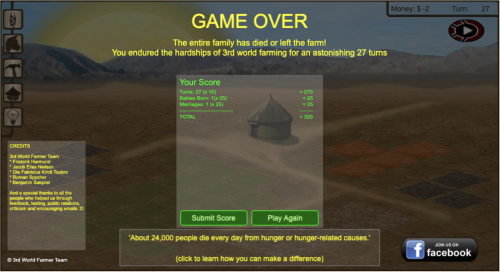
- Game/Simulation Title: 3rd World Farmer
- What was the game/simulation about?
This game shows me the real life of people in 3rd world. They have limited resources, bear diseases, are without good education, are short of medicines… Meanwhile, natural disasters like floods and droughts may be due to harvest failure. Petty thieves and corrupt officials may suddenly enhance the living burden on the people there. The player can play the role of a third-world farmer to experience their real challenges.
- Describe the game’s/simulation’s structure
- Core dynamic: Construct
- Main mechanics: progress buttons; points (wealth, health, family members population); rewards (corps harvest data); challenges (accidents and disasters); storytelling; role-playing; social interaction (the players are welcome to share the simulation results on the social medias)
- Game goal: to simulate the reality of the farms’ living in third-world countries or districts. It’s very hard for them to survive and live better.
- What did you enjoy/not enjoy while playing the game/simulation?
I felt sad while playing the game. However, I wasn’t sad because the game was badly designed but because it was well designed. It was designed so well to simulate the real challenges to the farmers in third-world countries and districts, which made me feel sad if I were one of them.
- Would you classify this as a game, simulation game, or simulation? Why?
I would classify this as a simulation since it is not for fun but for introducing farmers’ real lives in third-world countries or districts.
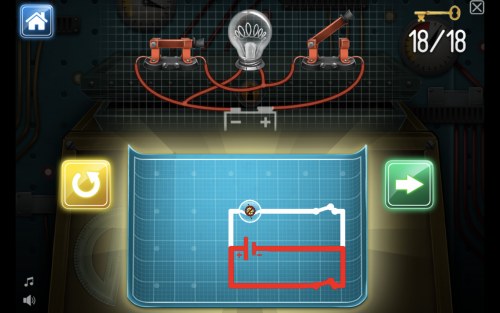
- Game/Simulation Title: Crack the Circuit
- What was the game/simulation about?
This game is about circuit knowledge. Players need to figure out the right way to link the power and terminals.
- Describe the game’s/simulation’s structure
- Core dynamic: Solution
- Main mechanics: Levels; Progress Bars (18 levels in total); Rewards (play congratulation music and sound when the player successfully figures out the circuit); Challenges; Feedback.
- Game goal: Motivate the help players learn circuit and electricity knowledge
- What did you enjoy/not enjoy while playing the game/simulation?
I enjoyed playing this simulation game because it provided me with real-time feedback about my right or wrong manipulations. It provided me with a safe environment to test my knowledge of electricity.
- Would you classify this as a game, simulation game, or simulation? Why?
I think it is a simulation game. It combines the joyfulness of the game and the meaningfulness of learning perfectly.
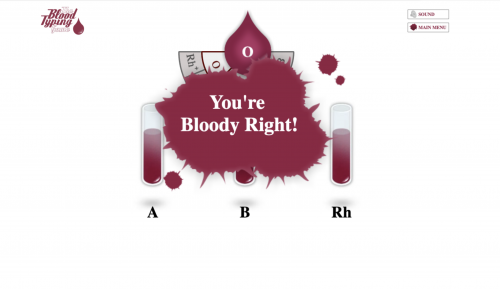
- Game/Simulation Title: The Blood Typing Game
- What was the game/simulation about?
This serious game is about learning the blood types. The player will play the role of a doctor in an emergency room to rescue a patient by starting to test the patient’s blood type. The player can learn the blood theory before playing.
- Describe the game’s/simulation’s structure
- Core dynamic: Solution
- Main mechanics: Progress bars; points; rewards (confirmation feedback); challenges (the player needs to understand the blood type theory first before successfully resolving the challenges); Storytelling; Role-playing; Feedback (error messages).
- Game goal: Motivate and help players learn blood type theory.
- What did you enjoy/not enjoy while playing the game/simulation?
I wish I had this game when I taught biology in middle school several years ago. The game visualized the different antigens in plasm and on the surfaces of different types of blood cells, which helped the players understand better the reasons behind the blood type theory.
- Would you classify this as a game, simulation game, or simulation? Why?
This is a serious game. Because it has very clear instructional aims, is built for non-entertainment, provides interesting and engaging challenges, and is designed to provide some form of skill development.
Read MoreAdvanced Design Game for Learning

I am excited to embark on my new learning journey in the Why So Serious Game Academy, facilitated by Arch McGee and supervised by Dr. Danielle Oprean. Last semester, the Design Game for Learning left a very deep impression on me. As an educator, I want to design and lead a high-efficiency online course in the future. Also, at the same time, I could imagine how much the hidden time and energy for preparing and fascilatating a course like this Dr. Oprean would cost. Beyond the skills and technologies for establishing the course, there must be uncountable passion and consideration for the learners.
In this semester, I have three different leveled expectations for my learning in this course: Advanced Design Game for Learning.
The things I must master:
- All the assignments will be finished in time.
- All the projects will be finished as required.
- All the assigned content will be reviewed.
The things I want master:
- Equip more advanced game-based learning skills.
- Link the learning content to my publishable manuscripts.
The things I may master:
- Learn how to establish a high-standard game-based online course like Advanced Designing Games for Learning.
Vocabulary Detective Presentation
Video Transcript:
Hi everybody, I am Yupei. In this presentation, I am going to introduce my game Vocabulary Detective created by Construct 3 game Engine. This presentation is also the part 2 of my level 5 assignment in the course of Designing Games for Learning advised by Dr. Oprean.
In my presentation, you will see the following topics:
Game title: Vocabulary Detective
Overview of the game
- Game Goal: In this game, you will play the role of a detective to match the right graphics with the right words, complete word spellings, and compose sentences using given words. The sentence you ultimately compose will contain clues to the thief’s hiding place, based on clues, you will find the thief as a successful detective.
Describe the narrative: It’s a game blending realism and fantasy, set in an elementary school named “G school”.
Characters introduction:
The main character is a 2nd-grade student, who is a vocabulary detective. Besides the main character, there is a thief hiding somewhere in “G school”, along with a teacher and a police officer who are searching for the thief.
The thief presents a challenge in the game, designed to arouse players’ passion for playing and learning. The teacher and the police officer are Non-player characters who are also very important components of this educational game. In real life, it is not recommended for kids to confront criminals directly. The right way for them in this kind of situation is to report to school faculties or police officers. The protagonist in our game is a fictional character with special abilities to tell more information from English words and sentences. The game you are about to play is the first episode of this game series.
Game Background Introduction:
One day, a thief stole items from a primary school, some items were missing, and many items in the classroom and on the campus were made messy by the thief as well. Teachers and policemen are reorganizing the items and searching for the thief on the campus. The player will assume the role of a special detective – vocabulary detective, who can find the secret behind the letters, words and sentences. With the broad knowledge of vocabulary and strong intuition of language, can the detective find the clues of the thief?
Learning objective: 2nd Grade students will be able to compose a simple English sentence by using the given words.
Core Loop (How to play)
During the game playing, the player will experience three game levels. Firstly, to push the graphics to the relative English words, once a graphic matches to the correct word, the player gets the reward points. In this level, the player will learn or review the English words and remember their meanings. Second game level, the player will push the missing letters to finish the word spellings they have seen in the first level. In this level, the players will get more chances to be familiar with the words. Third level, based on understanding the meanings of the words and their spellings, the player will push the words to the right places to finish an English sentence. The finished English sentence will tell the clues of the thief’s hidden place. The players will find the thief by correctly understanding the meaning of the English sentence. Finally, the thief will be caught by the policemen with the help of the vocabulary detective and teachers.
Keep an eye on the time while you are playing. You need to finish each level in 99 seconds. Do not waste too much valuable time, or you might let the thief escape.
This is a “Sokoban style” game, meaning you can use the four arrow buttons to move the vocabulary detective around in the game.
Now, let me show you quickly about the real game setting. You can go to the game website to start the game. Once you launch the game, you will read the brief instructions of how to play, which will also remind the players of the game goals. Read the instruction, then go to play level 1. The game scenarios are quite straightforward where you can explore and do some trials and errors as you wish.
When you have an idea about how to match the graphics, control the vocabulary detective to push the graphics to match the relative words. Each correct match will earn you 10 points, while each incorrect match will deduct 10 points from your total. Additionally, if you make a wrong match, you will have to replay the level from the beginning. After finishing all the matches, you can use the exit to go to the next level.
The same rules are used in the different levels, but the challenges are becoming harder and harder. For level 2, you need to finish the word spelling with the right missing letters. Based on your memory about the words in level 1, you can tackle the problems in level 2. Now, you not only remember the meaning of the words, but will also be familiar with spellings. Then, let’s go to level 3.
In level 3, there is a half-finished sentence. You can check the sentence and the given words which you can use to finish the sentence. Pay attention to both grammar and logic to construct a meaningful English sentence. After finishing the sentence, you can read through it to find the clues of the thief’s hidden place. For example, the sentence might be, “The thief put a pencil and an eraser into his bag to hide behind the biggest tree.” Now, you may notice there are some trees in the level 3 game scenario. You need to tell which tree is the biggest one? Try to find the thief behind the biggest tree. Once you reach the location of the biggest tree, the thief will be caught by the policemen, and you will get an extra 50 points as reward.
Congratulations, you win, vocabulary detective.
What makes it a learning game?
The Picture Word Inductive Model (PWIM) was developed by Emily Calhoun. It has been defined as “An inquiry-oriented language arts strategy that uses pictures containing familiar objects and actions to elicit words from children’s listening and speaking vocabularies.” This model helps develop primary or early-stage readers’ vocabulary, reading and writing skills, through building on what they already know.
Engage students in shaking words out of a picture—words from their speaking vocabularies—to begin the process of building their reading and writing skills. Use the picture word inductive model (PWIM) to teach several skills simultaneously, beginning with the mechanics of forming letters to hearing and identifying the phonetic components of language, to classifying words and sentences, through forming paragraphs and stories based on observation(Calhoun, 1999).
Declarative knowledge and rules-based knowledge(Kapp, 2012) are the learning domains of my game.
Declarative knowledge
- Matching: match the word to the picture which shows its meaning.
- Repetition: to find the right letters to finish the given word spelling.
Rules-based knowledge
- Experience Consequences: Compose the correct English sentence with the given words.
The purpose of keeping the players engaged is to report the missing items in the school to teachers and help the police catch the thief. The climax of the story involves using the right words to compose a correct sentence, based on an understanding of the words’ meaning and usages. The sentence is the clue to the thief’s hiding place. If the player understands the sentence correctly, he or she will help police find the thief more easily. The rising actions involve becoming familiar with the meanings of the words in the first and second levels. The game is designed to foster students’ interest in learning English vocabulary. The more vocabulary the players have, the higher scores they can get in the game.
Core Dynamic
Race to the finish, and Matching.
Scoring, Reward, Assessment
Scoring: The initial score is 100 points. Each correct matching will add 10 points. Meanwhile, each wrong matching will reduce 10 points.
Reward: If the players follow the clues to find the thief successfully, an extra 50 will be added to the sum points.
Assessment : The game system will evaluate the players on their accuracy of the vocabulary knowledge when they play the game. The higher the score they get, the better understanding about the vocabulary they have.
James Paul Gee is a leader in the research of game-based learning. He wrote a paper called Good Video Games and Good learning which outlines 16 principles critical to strong Game based learning. My game mainly focuses on two of the principles.
- Identity – with clear goals and clear roles, games invite players to take on different roles and invite the players to become different people and try new activities(Why Game Based Learning Will Make Your Child Smarter?, 2020).
In my game, I want to invite a player to take the role of a sort of superhero to help the police officer and school faculty to find the thief. Let them experience “Knowledge is powerful”.
- Empowered Learners – learners must feel like what they do matters(Why Game Based Learning Will Make Your Child Smarter?, 2020). I hope the players can really use daily learning in their classrooms to resolve problems. This game embedded the common vocabulary a 2nd grader should master. Beyond asking the primary students to practice the words by reading or writing, the game provides another possibility to be familiar with them.
Thanks for all the tutorials makers and resources providers. Thanks to the peer reviews from my fellow classmates. Thanks to Dr. Oprean’s help and guidance.
References
Why Game Based Learning Will Make Your Child Smarter? – EdTechReview. (2020, July 23). https://www.edtechreview.in/trends-insights/trends/why-game-based-learning-will-make-your-child-smarter/
Tutorial
Sound and background music :https://www.youtube.com/watch?v=X6y0lTeOURE
Countdown timer: https://www.youtube.com/watch?v=V8BRbEJP7e8
Assets:
Audio:https://www.kenney.nl/assets/category:Audio?sort=update https://www.kenney.nl/assets/impact-sounds Background music:https://freesound.org/
Personal reflection to Design Games for Learning Course

(Fig. Personal Reflection. Created by Yupei and ChatGPT. )
The most insightful thing I got from this course
The Designing Games for Learning course started from introducing James Paul Gee’s 13 learning principles that games can teach us how to teach, and ended back to reflect on the 13 principles. This was not a simple loop, but an iterative process with constructive learning, peer reviewing, insightful feedback and forever tuning….
Just like Carla Arena concluded on his blog(Why Game Based Learning Will Make Your Child Smarter?, 2020) about James Paul Gee’s 13 learning principles that games can teach us, “Teaching should be designing and resourcing learning for people. So, teaching and gaming are closely related. The question for teachers is ,”How do we design learning? What tools do we use? Games is one of those tools. They have a lot to teach us of what good learning design is all about.”
There were many takeaways from this course I can use in my future instruction design, and the most insightful is keeping the 13 principles in my mind not only for designing serious games, but also in my daily working and life.
What do I still want to know about?
Gamification is a powerful tool for curriculum designers and instructors. One of the ideal goals of the educators is to foster more students to be lifelong learners. When the learners have the ability to transfer their learning content to be interesting and funny like playing games, they would be more able to enjoy their learning. I want to know the answers about how educators can help learners use the gamification competencies in their own self-learning journeys, especially for some challenging learning projects. It’s vital and beneficial for a lifelong learner.
The ins and outs of design?
Design part is amazing and necessary for a game. The impressive and friendly design will bring a harmonious feeling to the learners to engage them deeper in the learning process. Both the Twin game and Construct 3 game designs include the similar design processes, skills and philosophies.
Good design always starts from a good idea, a right starting point. The author of the book The Design of Everyday Things (Norman, 2013), Don Norman said,”In design, the secret to success is to understand what the real problem is.” I can not agree with this more. During the process of designing Twin game and Construct game, the proper instructional content and objectives are more important than the design skills and technologies. Twin engine is more suitable to design story narrative games, and Construct engine will be more helpful to develop 2D interactive games.
Based on a right starting point, the design should be followed by a clear and informative design blueprint. Since I have been learning the basic skills about how to use the game engines, there were a lot of new functions I found I could use in the game engines to fulfill some instructions in different ways, so there were quite a lot of changes in my projects through my learning process. With more understanding about the game engines and tools I can use to create games, the design part will be improved at the same time.
Were you successful in acquiring attributes throughout the training?
I am so happy that I tried a lot in this course. Although there were some aspects I could do better, for example, the Twin game engine and the Construct 3 game engine have potential functions to develop serious games, the limited time pushed me to skip a lot of practice on them. But, I still got more things than I imagined before registering for this course. Beside the solid knowledge and useful skills in this course, I think I got one more view angel from a game designer to observe instructions and games. Based on the training, I can translate my instructional ideas better to the game designers, at the same time, I can provide more possibilities about designing games to tackle some problems for instructors.
Discuss which skills you claimed during your time and how they helped you as you worked through each level
The whole learning process in this course is like playing a game. I have Arch McGee and Dr. Oprean as my game guides. I used Blogs to reflect my learning. The game projects were the milestone in this course. The badge system shows my learning journey more visually. One more important thing for enhancing my skills acquired was the collaboration with Dr. Oprean and Nicholas Rankin at the BIG grant project during the learning journey. Standing at the end of the whole learning journey, I can better understand a paragraph in the book The Gamification of Learning and Instruction (Kapp, 2012), “Gamification has been used to teach everything from psychomotor or physical skills to cognitive skills – and even for influencing attitudes. Gamification can teach memorization to higher order thinking and every cognitive level in between. It can also be used for assessing a learner’s abilities, knowledge, and skills[Gamification of Learning and Instruction]. ” Because I have improved my different types of skills as well, especially for my high order skills.
Among the different higher order skills, thinking strategically about positioning, analyzing opponent strengths and weaknesses, planning how to achieve game goals,and executing those plans is the most important.
Beyond this training, I can use this skill to tackle more challenging problems in my research, learning and ordinary life. I believe all the project developments share the similar process and design principles. Understand better about the resources I have, the skills I mastered, and the goals I want to achieve, then to make a reasonable plan and follow the design plan to finish the projects.
My view toward games for learning and subsequently gamification has changed
My view toward games for learning was changed in this course. Initially, there were a lot of concerns in my mind about using games in my instruction. Since I thought the games were for entertainment, but not for learning. Even though some games contain educational elements, they could have some side-effects for learning. But, I knew there were a type of serious games designed for learning, which were quite different from the commercial games. At the same time, the books The Educator’s Guide to Designing Games and Creative Active – Learning Exercises: The Allure of Play (Bisz et al., 2023) by Joe Bisz and Victoria L. Mondelli and Reality is broken: Why Games Make Us Better and How They Can Change the World (McGonigal, 2011)by Jane McGonigal brought me more information about the possibilities games can do for our life and our future from hand-on games and video games respectively. My attitude to games has changed.
My definition of a serious game now
Serious games are not only an instructional tool for me as an instructor, but also an elegant metaphor to remind me to live a positive and joyful way as a person now. There is a Chinese proverb, “Bitter hard-working is the boat sailing on the endless sea of learning (学海无涯苦作舟).” I was told and trained to bear the difficulties and challenges during the learning process to yield more production. Luckily, learning has been an interesting thing to me, especially for the content I have been interested in. For the challenging part of learning, one way to make the learners feel they are easier is gamification by using serious games. Of course, if the learners can use the serious games to change their learning content and learning methods, that will be fantastic. Recently, especially after learning this course, I think the proverb should be changed a little bit to “Bitterly and hardly to work to build your happy boat, then sail on the endless sea of learning (学海无涯苦做舟)”. If life is a journey, the best strategy is to enjoy the whole process. Just like Sid Meier said, “I think that in life, as in game design, you have to find the fun. There is joy out there waiting to be discovered, but it might not be where you expected.”
References
Norman, D. (2013). The Design Of Everyday Things (Revised edition). Basic Books.
Read MoreSelf-Reflection to Level 4: Vocabulary Detective: Digital Game Design Document & Construct 3
I finally finished the prototype of Vocabulary Detective, here is the Game link:https://yuepei.itch.io/vocabulary-detective
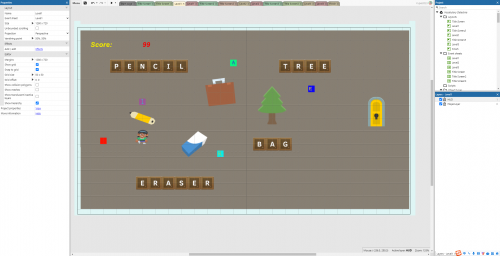
Level 1: match the graphics to the words
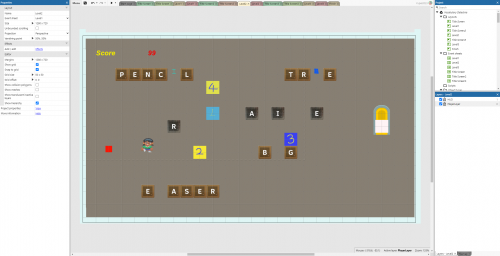
Level2: finish the word spellings
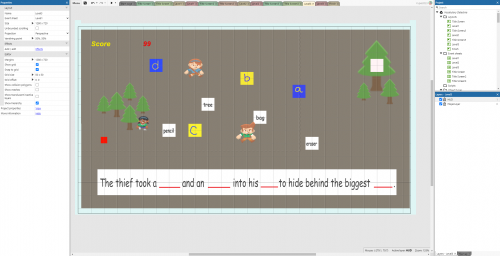
Level3: finish the sentence.

Game Overview
In this game, you will play as a detective to match the right graphics with the right words, to finish the word spellings, and to compose your sentences with the given words. The sentence you finally finished composing contains the clues of the hidden place of the thief, based on that, you will find the thief as a successive detective.
Learner/Player
The intended users are Grade 3 students in primary schools at Columbia, Missouri. They are 7-8 years-old girls. The boys will play another version of the game with different boy-player graphics. Other elements of the game will be the same. The kids are learning to spell new words related to learning tools. No need so much game experience for playing this game, only can use 4 different direction buttons to control the player to different directions when it is necessary. For the subject matter knowledge, the learners should know the right spellings of the common learning tools.
Subject Area
English Language Arts
Knowledge Domain
Declarative knowledge and rules-based knowledge(Kapp, 2012) are my game’s learning domains.
Declarative knowledge
- Matching: match the word to the picture which shows its meaning.
- Repetition: to find the right letters to finish the given words.
Rules-based knowledge
- Experience Consequences: Compose the correct English sentence with the given words.
Learning Objectives
Instructional objective: Grade 3rd students will be able to compose a simple English sentence by using the given words.
Supporting objectives:
- After playing the game, the players will be able to match the right graphics with the relative English words.
- After playing the game, the players will be able to correctly spell the given English words.
Game Goal
The overall goal of playing the game is to assist Grade 3rd students to learn and review common English words; practice composing English sentences. The players will try to use less time to remember the meaning of the words, familiarize the spellings, then try to use the words to compose sentences correctly. The more accuracy and the less time cost will gain extra points.
Game Description
This is a “Sokoban style” (pushing box) game. The player will experience three game levels. Firstly, to push the graphics to the relative English words, once a graphic matches to the correct word, the player gets the reward points. After playing, the player will learn or review the English words and remember their meanings. Second game level, the player will push the missing letter(s) to finish the word spellings they have seen in the first level. In this level, the players will get more chances to be familiar with the words. Third game level, based on understanding the meanings of the words and their spellings, the player will push the words to the right place(s) to finish an English sentence. The finished English sentence will tell the clues of the hidden place of the thief. The players will find the thief with understanding the meaning of the English sentence. Finally, the thief will be caught by the vocabulary detective with the help of police men and teachers.
Environment
It’s a half-realistic and half-fantastic game that takes place in an elementary school named G school (Fig.1).
Fig.1 Game Environment
The player will see a classroom with messy graphics and English words. A message from the teacher tells her that a thief stole items from the classrooms. The second classroom has English words with missing letters. The player will compose the English sentence in the third classroom and find the clue of the hidden location of the thief.
Story/Narrative
There is a story that helps players engage with the game. One dark night, a thief stole some valuable knowledge, made the items of instruction and learning in the classrooms a total mess in G School. The next morning, a Grade 3rd student asks to help teachers reorganize the teaching and learning items in the classrooms. The player will manipulate the four direction buttons on the keyboard to put everything back to the proper places. The player will see the graphics of the english words, English words, English words with missing letters, English sentences with missing words in different scenarios. The play will push the messy items which were disturbed by the thief to the original places, then find the lost items to report to police.
The purpose to keep the players moving forward is to save more time to report the missing items in the school to police. The faster the vocabulary detective finishes the matching, the quicker the police will understand the real loss in the campus to take action to catch the thief.
The climax of the story is using the right words to compose a correct sentence, which is based on the understanding of the meaning and usage of the words. The sentence is the clue to the thief’s hiding place. If the player understands the sentence correctly, he or she will help police find the thief more easily. The rising actions are being familiar with the meaning of the words in the first and second scenarios. The game helps foster students’ English vocabulary learning interests.
Characters
The main character is a Grade 3rd student, a vocabulary detective. Except for the main character, there is a thief hiding somewhere in G school, a teacher and a police officer who are searching for the thief.
The thief is a challenge in the game to arouse the passion of playing and learning. The teacher and the police officer are Non-player characters who are also very important components of this educational game. In real life, the kids are not recommended to face the criminals directly. The right way for them in this scenario is to report to adults or police officers.
Core Dynamic
Race to the finish, and Matching.
Gameplay
Core loop: The player will control a detective (sprite 1) to use the clues (English sentence) to resolve the crosswords puzzles and match the relative graphics, then use the words to compose an English sentence as soon as possible. Each correct match will add the score.
Action: The players will manipulate the four different directions buttons to control the spite to finish the tasks in the game.
Scoring, Reward, Assessment
Scoring: The initial score is 100 points. Each correct word matching will add 10 points, and each correct sentence matching will add 20 points. Meanwhile, each wrong matching will reduce 10 points.
Reward: The players will start from the game with a 120 seconds back counting timer. The left time will be calculated as extra points, each second equals to one point, to add to the score. The more proficient the player with matching, the higher points the player will get. The top 3 achievements will be recorded and will be viewable to other players.
Assessment : The game system will evaluate the players on their speed and accuracy when they successfully finish all the right matchings.
Gee Principles
- Identity – Clear goals and clear roles, games invite you to take on different roles and invite you to become different people and try new activities(Why Game Based Learning Will Make Your Child Smarter?, 2020).
In my game, I want to invite the players to take the role of a sort of superhero to help the police officer and school faculty to find the thief. Knowledge is powerful.
- Empowered Learners – learners must feel like what they do matters(Why Game Based Learning Will Make Your Child Smarter?, 2020). I hope the players can really use daily learning in their classrooms to resolve problems.
Description of Planned Construct 3 Game Implementation
I have been designing two letters and two objectives the letters should be pushed to by the player. If the right letter were pushed to, the system will add 10 points to the score, instead of the wrong letter being pushed to, then 10 points will be decreased from the total score. The same logic will be copied to more letters, graphics and word sprites.
There are some tutorials, resources I have been using
- Platformer game design tutorial: https://www.construct.net/en/tutorials/platformer-game-2329
- Top-down shooter game (score function) design tutorial: https://www.construct.net/en/tutorials/beginners-guide-construct-1
- Pushing box in construct 3 tutorial: How to make pushing box in Construct 2 & Construct 3 – YouTube
- Resource: Toon characters 1: Toon Characters 1 · Kenney
- Resource: Sokoban: Sokoban · Kenney
- Resource: Generic items(deceleration):Generic Items · Kenney
- Resource: Letter Tiles:Letter Tiles · Kenney
- Resource: Puzzle pack:Puzzle Pack · Kenney
Screenshots
Fig 2. Code event sheet
Fig 3. Play view
References
Tutorial
Sound and background music :https://www.youtube.com/watch?v=X6y0lTeOURE
Countdown timer: https://www.youtube.com/watch?v=V8BRbEJP7e8
Assets:
Audio:https://www.kenney.nl/assets/category:Audio?sort=update https://www.kenney.nl/assets/impact-sounds
Background music:https://freesound.org/
Read More